Research methods
Zohar Amar has been involved in various areas of research that link Torah and science, presenting a new examination of the classical Jewish sources and offering a different perspective on conventional thinking. His approach is to harness contemporary research techniques to scholarship in Jewish Studies. In his research he tries to apply almost every available piece of information, making extensive use of Hebrew literature and Arabic literature and the early, classical sources including ancient Greek, Latin, and Syriac literature. Special emphasis is placed on Jewish and Moslem sources which were written in Arabic in the Middle Ages, presenting their contribution to an understanding of the cultural and material flowering in the Islamic world. Many studies were devoted to understanding the realia embedded in the treatises written by R. Saadia Gaon and Maimonides.
Another of area of his research is related to an identification of the flora and fauna mentioned in the Scriptures and the rabbinical writings. In his recent works, Amar proposes a critical reappraisal of present identifications and a re-classification by levels of probability (i.e.: certain, doubtful). His approach gives the tradition of identification the highest rating of all measures that exist today in this field of scholarship. He also published, in collaboration with other scholars, a new proposal for identifying the ‘clean’ animals in the Torah in light of the archaeo-zoological findings uncovered in the Land of Israel and its environs. A considerable part of his work is devoted to the study of the plant life and agriculture mentioned in the Scriptures, Mishnah, and Talmud, which includes actually cultivating crops and reconstructing the manufacture of the products derived from them. Among others he has replicated the production of milkweed fabric, deciphered the inscription of "Šmn Rahus" mentioned on Samarian ostraca, proposed a recreation of the Temple showbread, initiated the restoration of the balsam plant to Israel, discovered the scarlet dye of the Torah (the Kermes oak coccid) and produced dye from it, replicated the purple dye [argaman], made an identification of dyes in ancient textiles and a historical and laboratory identification of the raw materials used in papermaking in the Middle Ages in light of scientific testing of documents from the Cairo Genizah.
History of medicine in the ancient world
A study of the history of medicine in the ancient world has become one of the most important fields of research in historical scholarship. Amar established, in collaboration with Professor Efraim Lev (of the University of Haifa), the “Unit on the History of Medicine in the Land of Israel”, one of the most important centers of academic research in Israel operating in this field. Research focuses on documenting the medical tradition from the ancient world until the present, especially Materia Medica, the spices used in the Temple incense and perfume, and it included a comprehensive ethnopharmacological survey conducted in marketplaces that specialize in selling traditional medicinal spices and herbs in Israel, Jordan, and Morocco. Recently he completed a comprehensive survey of Materia Medica used by the Ethiopian community in Israel (in collaboration with Dikla Danino). Another prominent study dealt with practical medicine in the Middle Ages in the Middle East according to medical prescriptions found in the Cairo Genizah.
Zohar Amar has published in collaboration with colleagues several ancient medical manuscripts, such as the treatise of the Jerusalem physician a-Tamimi (10th century), the Sori ha-Guf by R. Nathan ben Yoel Falaquera (13th century), Practical Medicine of Rabbi Hayyim Vital (16th century), and P’ri Megaddim by Rabbi David de Silva, Physician of Jerusalem (18th century).

Saʿadia ben Yosef Gaon was a prominent rabbi, gaon, Jewish philosopher, and exegete who was active in the Abbasid Caliphate.
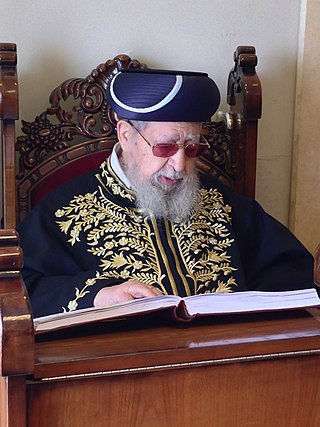
Ovadia Yosef was an Iraqi-born Talmudic scholar, a posek, the Sephardi Chief Rabbi of Israel from 1973 to 1983, and a founder and long-time spiritual leader of Israel's ultra-Orthodox Shas party. Yosef's responsa were highly regarded within Haredi circles, particularly among Mizrahi communities, among whom he was regarded as "the most important living halakhic authority".
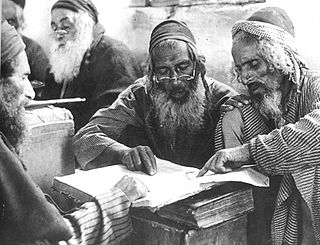
Yemenite Hebrew, also referred to as Temani Hebrew, is the pronunciation system for Hebrew traditionally used by Yemenite Jews. Yemenite Hebrew has been studied by language scholars, many of whom believe it retains older phonetic and grammatical features lost elsewhere. Yemenite speakers of Hebrew have garnered considerable praise from language purists because of their use of grammatical features from classical Hebrew.

Shlomo Moshe Amar is the former Sephardic Chief Rabbi of Israel. He served in the position of Rishon LeZion from 2003 to 2013; his Ashkenazi counterpart during his tenure was Yona Metzger. In 2014 he became the Sephardic Chief Rabbi of Jerusalem.

Avraham Shapira was a prominent rabbi in the Religious Zionist world. He served as the Ashkenazi Chief Rabbi of Israel from 1983 to 1993. Shapira was the head of the Rabbinical court of Jerusalem, and both a member and the head of the Supreme Rabbinic Court. He was the rosh yeshiva of Mercaz haRav in Jerusalem, a position he held after Rabbi Zvi Yehuda Kook died in 1982.

Kermes is a red dye derived from the dried bodies of the females of a scale insect in the genus Kermes, primarily Kermes vermilio. The Kermes insects are native in the Mediterranean region and are parasites living on the sap of the host plant, the Kermes oak and the Palestine oak.

Rabbi Uri Zohar was an Israeli film director, actor and comedian who left the entertainment world to become an orthodox rabbi.
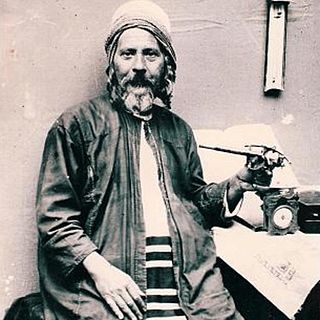
Yiḥyah Qafiḥ (1850–1931), known also as "Ha-Yashish", served as the Chief Rabbi of Sana'a, Yemen in the late nineteenth and early twentieth centuries. He was one of the foremost rabbinical scholars in Sana'a during that period, and an advocate of reforms in Jewish education. He was also learned in astronomy, and rabbinic astrology and Jewish classical literature.
Vendyl Miller Jones was an American Noahide scholar who directed archaeological searches for biblical artifacts such as the Ark of the Covenant.
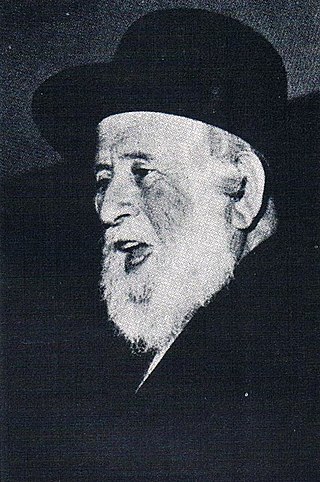
Reuvein Margolies, was an Israeli author, Talmudic scholar and head of the Rambam library.

Kosher locusts are varieties of locust deemed permissible for consumption under the laws of kashrut. While the consumption of most insects is forbidden under the laws of kashrut, the rabbis of the Talmud identified eight kosher species of locust. However, the identity of those species is in dispute. The Jewish communities of Yemen and parts of northern Africa, until their emigration in the mid-20th century, ate locusts which according to their tradition are kosher. Some such species can be bought in Israel for consumption. In 2020, the National Rabbinate of Israel approved locusts as kosher (Pareve) for the first time: after inspecting and ensuring that modern agriculture technologies developed by Hargol FoodTech provide only kosher approved locusts species. The company sells its locusts and other food products fortified by locust protein under a special brand "Holy Locust"

Aryeh Stern is the Ashkenazi Chief Rabbi of Jerusalem, a member of the Chief Rabbinate Council of Israel, and the chief editor of the Halacha Brura and Berur Halacha Institute.
The following outline is provided as an overview of and topical guide to Judaism:
Jewish vegetarianism is a commitment to vegetarianism that is connected to Judaism, Jewish ethics or Jewish identity. Jewish vegetarians often cite Jewish principles regarding animal welfare, environmental ethics, moral character, and health as reasons for adopting a vegetarian or vegan diet.

Amram Aburbeh, also spelled Abourabia and Aburabia, was the Chief Rabbi of the Sephardic congregation in Petah Tikva, Israel and author of Netivei Am, a collection of responsa, sermons, and Torah teachings.

Am Yisrael Foundation is a Tel Aviv and New York–based foundation and umbrella nonprofit organization for a variety of initiatives that promote Zionist engagement among Jewish young adults residing in Israel, including providing leadership platforms for young Jews who have made Aliyah, or are contemplating immigration to Israel.

Yitzchok Shlomo Zilberman was an Israeli Haredi rabbi and educator, pioneer of the Zilberman Method of Torah study. He founded Yeshivat Aderet Eliyahu, part of a community that follows the path of the Vilna Gaon.
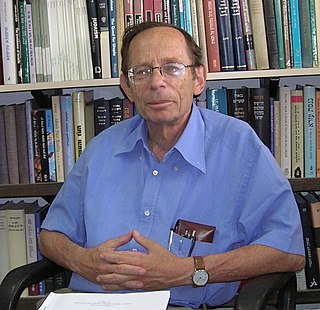
Gerald Blidstein was professor emeritus of Jewish philosophy at Israel's Ben-Gurion University of the Negev. He was the Israel Prize laureate in Jewish philosophy (2006) and had been a member of the Israel Academy of Sciences since 2007.

Nathan ben Abraham, known also by the epithet President of the Academy in the Land of Israel, was an 11th-century rabbi and exegete of the Mishnah who lived in Ramla, in the Jund Filastin district of the Fatimid Caliphate. He was the author of the first known commentary covering the entire Mishnah.
Efraim Lev is a professor in the Department of Israel Studies and Dean of the Faculty of Humanities at the University of Haifa. He is the immediate past Head of the Centre for Interdisciplinary Research of the Cairo Genizah at the University of Haifa, and the Department of Humanities and Arts at the Technion-Israel Institute of Technology. He also headed the Eshkol Department of Multi-Disciplinary Studies for special programs and undergraduate degrees in the University of Haifa’s Faculty of Humanities (2013-2018). Lev specializes in the history of medicine and pharmacology in the Middle East, in particular from the Middle Ages and the early modern period.
















